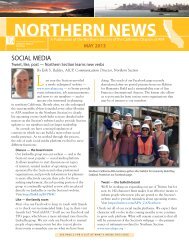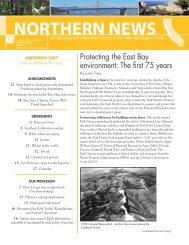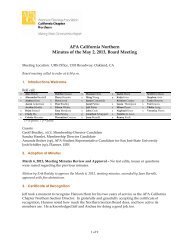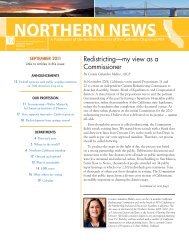Plan-it sustainably - Northern California Section
Plan-it sustainably - Northern California Section
Plan-it sustainably - Northern California Section
You also want an ePaper? Increase the reach of your titles
YUMPU automatically turns print PDFs into web optimized ePapers that Google loves.
What others are sayingFeel free to smile at thishttp://b<strong>it</strong>.ly/X9A1Uq“If you smile at your boss and she smiles back, beware.It could be a sign that she does not think too highly of you,according to a study. People who feel powerful are more likelyto mimic the smiles of those they perceive as low status,according to research presented at the annual Society forNeuroscience conference in New Orleans, Oct. 15th. Theyare less likely, however, to return the smiles of people theyconsider of higher status than themselves. And when peopleare not feeling particularly powerful, they return everyone’ssmiles almost equally. Evan Carr, UCSD, led the study.Power, he said, refers to someone’s internal feeling of beingable to take control of others, whereas status is a moreexternally defined qual<strong>it</strong>y. ‘It’s more to do w<strong>it</strong>h perceivedreverence or some type of social hierarchy,’ said Carr.”—Alok Jha, “Status affects how readily people return smiles,research reveals,” The Guardian, Oct. 14, 2012.[Ed. note: I worked for someone for three years who always smiled whentalking to me, on any subject. It was only during my third year that acolleague informed me the boss had suffered facial injuries in a carcrash, and the permanent smile resulted from reconstructive surgery.]Ideological divide between c<strong>it</strong>ies and suburbshttp://b<strong>it</strong>.ly/UPAfNq“The Republican party seems to have abandoned urban coresto the Democrats, preferring to stake out rural, semirural,suburban, and exurban terr<strong>it</strong>ories. … There is an underlyinglogic to a pol<strong>it</strong>ical spl<strong>it</strong> in physical terr<strong>it</strong>ory. C<strong>it</strong>ies can onlyexist through the continual presence of a great deal of infrastructurethat is visible. Mass transportation, cops on thebeat, util<strong>it</strong>ies, and everything that lets people live in suchclose quarters is necessary and in your face. It is clear whygovernment is necessary, and that we live in a society ofcontrasts. In the suburbs, much is invisible. The only largescaleinfrastructure you see are the highways that get you towhere you live. The suburbs would not have existed to theextent that they do w<strong>it</strong>hout the massive amounts of moneywe put into everything from electrification to highways,but the bulk of that investment is now merely a fact on theground. The suburbs … are a dream of living w<strong>it</strong>h naturew<strong>it</strong>h all of the modern conveniences … while hidingdivisions, fissures, and real<strong>it</strong>y.” —Aaron Betsky, “Smoke,Mirrors, and Oz,” Arch<strong>it</strong>ect (AIA), Oct. 9, 2012.<strong>Plan</strong>t many treeshttp://to.pbs.org/PXuY4qThe PBS NewsHour has “been looking at how the urbanheat island effect and climate change turn up the thermostaton U.S. c<strong>it</strong>ies, and how places like Chicago are trying tocool off w<strong>it</strong>h greener infrastructure. Hari Sreenivasan caughtup w<strong>it</strong>h [Peter] Calthorpe at the Aspen Environment Forum.He said the best thing c<strong>it</strong>ies can do to keep cool is planttrees. ‘It’s that simple,’ Calthorpe said. ‘Yeah, you can dowh<strong>it</strong>e roofs and green roofs ... but believe me, <strong>it</strong>’s that streetcanopy that makes all the difference.’” Watch the PBSinterview in a three minute video embedded in the articleby Rebecca Jacobson, “Key to a Cool C<strong>it</strong>y? It’s in the Trees,”PBS NewsHour, Oct. 9, 2012.Job not going swimmingly?http://b<strong>it</strong>.ly/OlrRqE“Dozens of c<strong>it</strong>ies across the globe are trying to re-createthe so-called High Line Effect. This fall, the mayor ofLondon and the c<strong>it</strong>y’s Landscape Museum hosted aconference and compet<strong>it</strong>ion aimed at helping the metropolisdevelop <strong>it</strong>s own High Line–inspired project. [Y/N] Studioproposes creating a new commuter network that wouldturn the 8.6-mile-long Regent’s Canal into a swimminglane, allowing Londoners to swim to work. In the winter,the designers imagine ice-skating. Much like +Pool(http://b<strong>it</strong>.ly/R1aNnd), the LidoLine would contain canalwater filtered through a multilayer membrane, removingbacteria and toxins. The canal was built nearly two centuriesago and, like the Erie Canal, was designed to transportindustrial goods to factories around the blossoming c<strong>it</strong>y.”—Kelsey Campbell-Dollaghan, “Will London be the firstc<strong>it</strong>y w<strong>it</strong>h commuter swim lanes?” Fast Company Design,Oct. 8, 2012.Latest twist in bullet train sagahttp://b<strong>it</strong>.ly/SBnzfm“Pending a high-speed rail legal challenge, the Madera andMerced County farm bureaus have asked a judge to freezeconstruction on a segment of the project. While a legalbattle plays out over the proposed route between Mercedand Fresno, the judge in the case has agreed to consider(continued on next page)<strong>Northern</strong> News 18 November 2012





![[NAME OF EVENT] EVALUATION FORM](https://img.yumpu.com/32351925/1/190x245/name-of-event-evaluation-form.jpg?quality=85)

